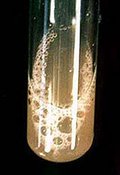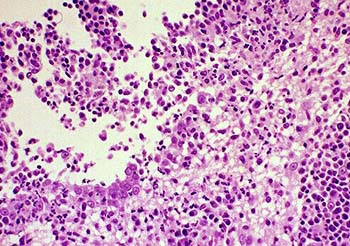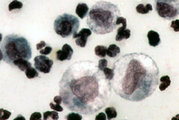 FIP effusive fluid
FIP effusive fluid
|
From Wikipedia the free encyclopedia, by MultiMedia |
 FIP-infected kidney showing inflammatory response
FIP-infected kidney showing inflammatory response
Feline infectious peritonitis (FIP) is a fatal, incurable disease that affects cats. It is caused by Feline Infectious Peritonitis Virus (FIPV), which is a mutation of Feline Enteric Coronavirus (FECV/FeCoV). Experts do not always agree on the specifics of FIP. However, the most common theory is that the normally benign FECV mutates into FIPV. The mutated virus has the ability to invade and grow in certain white blood cells. The immune system's response causes an intense inflammatory reaction in the containing tissues.
FECV is very common, especially in places where large groups of cats are kept together (animal shelters, catteries, etc). Cats become infected by inhaling or ingesting the virus. The most commonly cited transmission source is feces, although virus-contaminated surfaces such as food dishes and clothing can trasmit the virus as well.
Despite the prevalence of FECV, most infected cats do not develop FIP. Often exposure to FECV produces no symptoms, but may cause a mild upper respiratory disease. Therefore, a cat with no symptoms whatsoever might still be an FECV carrier and pass the virus to another cat. Even if FECV does not mutate in the carrier, the newly infected cat might still contract FIP.
 FIP effusive fluid
FIP effusive fluid
There are two main forms of FIP: effusive (wet) and non-effusive (dry). While both types are fatal, the effusive form is more common (60-70% of all cases are wet) and progresses more rapidly than the non-effusive form.
The hallmark symptom of effusive is the accumulation of fluid within the abdomen or chest, which can cause breathing difficulties. Other symptoms include lack of appetite, fever, weight loss, jaundice, and diarrhea.
Dry FIP will also present with lack of appetite, fever, jaundice, diarrhea, and weight loss, but there will not be an accumulation of fluid. Typically, though, a cat with dry FIP will show ocular or neurological signs.
 Cytology of FIP-induced fluid showing neutrophils, macrophages and lymphocytes
Cytology of FIP-induced fluid showing neutrophils, macrophages and lymphocytes
The symptoms associated with FIP are often non-specific, which can cause diagnosis to be very difficult. A definitive diagnosis requires examination of affected tissues for the FIP virus. This is usually performed post-mortem, but can be performed via tissue biopsy. Histopath examination of tissue samples is usually the cheapest and most readily available diagnostic, however a PCR test is also available for use with fluid or certain tissue samples that is considered definitive.
More commonly, a presumptive diagnosis is made based on clinical signs and evaluation of abdominal or chest fluid, if available. Fluid caused by FIP tends to be yellow in color and have elevated protein levels. Blood tests can also be performed to bolster a presumptive diagnosis by looking for coronavirus antibodies and elevated protein. Coronavirus titers are not considered diagnostic in and of themselves due to the ubiquity of FeCoV, but may be used in conjunction with clinical symptoms to make an FIP diagnosis.
As there is no cure for FIP, treatment is symptomatic and palliative. Typically the owner is advised to make the cat as comfortable as possible until it becomes clear that the cat is suffering. Prednisone or other immunosuppressive drugs prescribed by a veterinarian may help to prolong the cat's life for a few weeks or months, but may be contraindicated in certain cases due to concomitant infection(s). Effusive FIP usually progresses too rapidly for any meaningful therapy to be attempted.
Quarantine may be advised if there are other cats in the environment, however because the details of transmission aren't well understood desired measures of quarantine will vary among practitioners.
Cats, made by MultiMedia | Free content and software
This guide is licensed under the GNU Free Documentation License. It uses material from the Wikipedia.